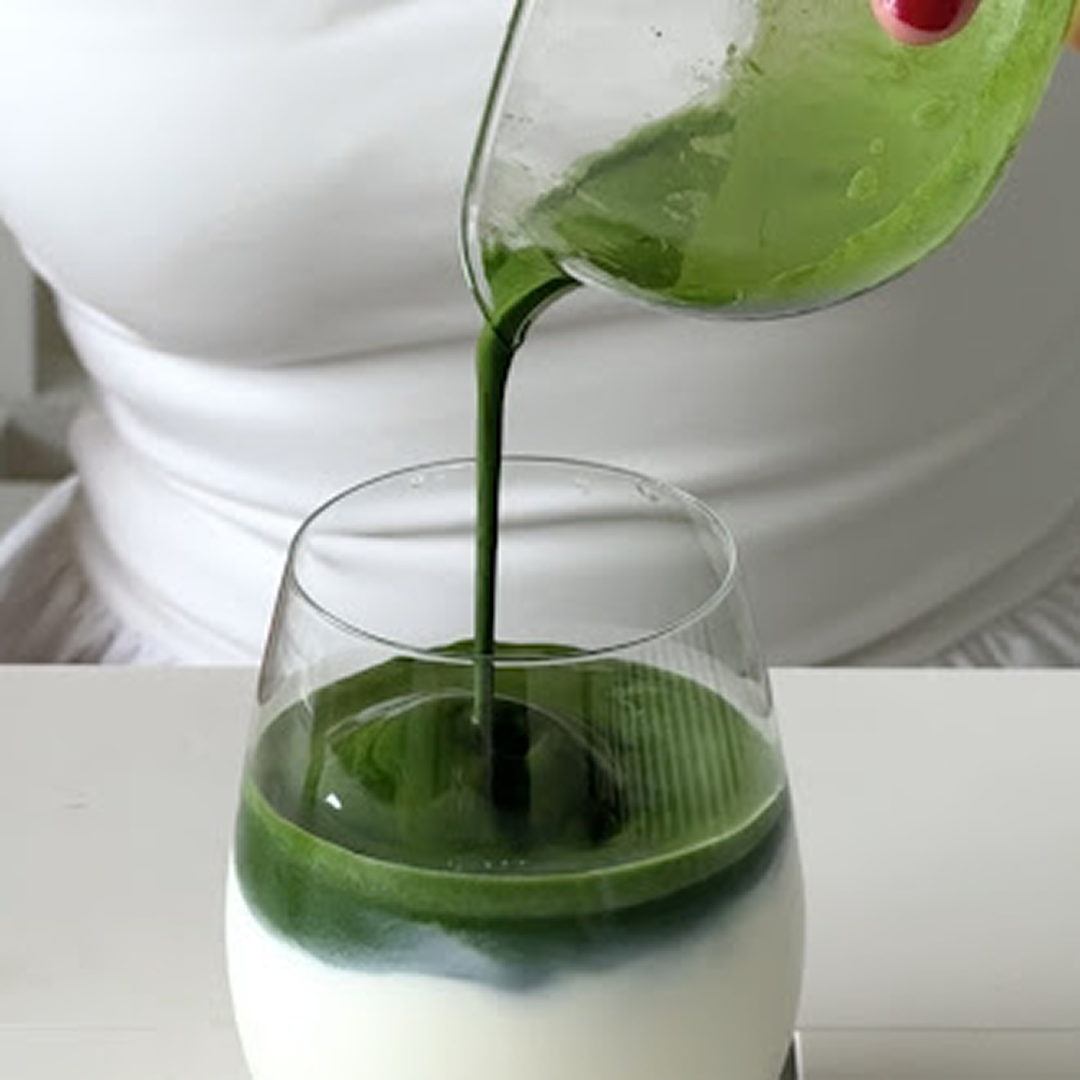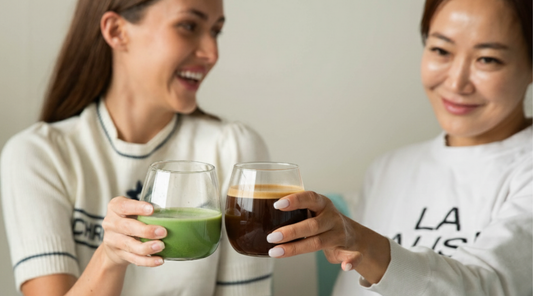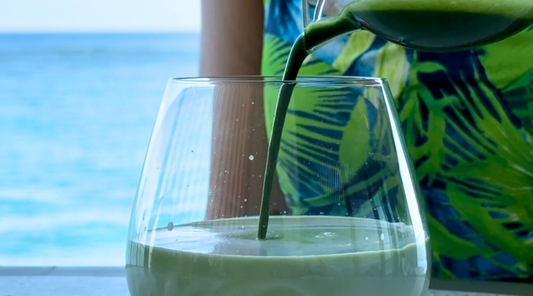
Best Milk for Matcha Lattes: Oat, Almond, Soy, Coconut or Dairy?
Share
If you love matcha lattes, you’ve likely wondered: Which milk gives the creamiest froth, the smoothest sip, and the most balanced flavour?
At Maison Koko, we’ve tested countless milk combinations ourselves – alongside cafés we collaborate with and insights from wellness partners we trust. These tests covered not just taste, but also texture, frothing ability, nutritional value, and how well each milk complements premium matcha.
In this guide, we’ll dive deep into how oat milk, almond milk, soy milk, coconut milk, and traditional dairy milk compare when used in matcha lattes. We'll look at taste, texture, frothing ability, health benefits, potential sensitivities, and even preparation tips – all backed by real-world experience and nutritional science.
Table of contents
If you’re new to matcha or want to better understand why milk choice matters, you might also enjoy our Ultimate Guide to Matcha Grades or explore how ceremonial vs culinary matcha affect taste and pairing.
Why Milk Choice Matters in Matcha Lattes
Matcha’s flavour profile is unlike coffee or black tea. It’s earthy, umami-rich, slightly grassy, and often subtly sweet. When choosing a milk, you're not just selecting a base – you’re choosing a flavour partner. The wrong milk can dull matcha’s nuance, make it taste chalky or sour, or even lead to separation and curdling.
Milk also impacts the mouthfeel of your latte. Some people love thick, creamy textures while others want a lighter, refreshing sip. And with the rise of plant-based milks, more people are looking for options that align with their dietary needs, gut health goals, or environmental values.
Check out our comprehensive guide to calories in matcha or matcha latte here.
Which Milk Makes the Best Matcha Latte?
Dairy Milk: The Classic Creaminess Standard
Taste: Whole milk has a naturally sweet and round flavour that tempers matcha’s vegetal notes beautifully. It enhances richness and brings out a mellow depth.
Froth: It’s the gold standard. The balance of protein and fat in whole milk produces silky, long-lasting foam that’s ideal for latte art or that café-style cream cap.
Nutrition: One cup provides ~8g of protein, calcium, vitamin D (fortified), and fat-soluble vitamins like A and K2.
Considerations:
- Not suitable for vegans or lactose-intolerant individuals
- May cause bloating or digestive discomfort for some
- Higher in saturated fat (esp. whole milk)
Who it’s best for: Those who want a classic café experience, prioritise protein, or aren’t sensitive to lactose.
Oat Milk: The Plant-Based Froth Powerhouse
Taste: Naturally sweet and slightly malty, oat milk complements matcha’s earthiness without overpowering it. It can soften bitterness and make the drink feel more indulgent.
Froth: Among plant milks, oat milk wins hands down, especially when using a barista blend. It steams well and creates a creamy, cohesive microfoam that holds shape.
Nutrition:
- Moderate in calories (~120 per cup), with ~2–3g protein
- High in beta-glucans (a type of fibre shown to support heart and gut health)
- Often fortified with B12, D, calcium
Considerations:
- Some brands include added sugar or seed oils (read labels!)
- Slightly higher glycemic impact than almond milk
- May separate in cold matcha unless shaken well
Who it’s best for: Vegans, froth lovers, or anyone seeking a creamy texture and balanced flavour without dairy.
Almond Milk: Light, Low-Calorie, and Subtle
Taste: Mild, slightly nutty, and much less sweet than oat milk. Almond milk can either elevate or clash with matcha depending on the brand and formulation.
Froth: Often underwhelming unless barista-style. Regular almond milk lacks the protein/fat content needed for stable foam.
Nutrition:
- Low calorie (~30–60 per cup), low in carbs
- Often fortified with calcium, vitamin E, and B12
- Naturally low in sugar and fat
Considerations:
- Tends to separate in hot drinks
- May taste watery unless using barista blends
- Some concerns about environmental water use during almond farming (if that matters to you)
Who it’s best for: Those seeking a lower-calorie, low-sugar plant-based option, especially for iced matcha.

Soy Milk: The Protein-Rich Plant Classic
Taste: Mild and neutral, with a slight bean-like finish. Balances well with matcha's umami and doesn’t overpower the tea’s natural flavour.
Froth: Excellent frothing capacity due to its higher protein content (most similar to dairy among plant milks). Produces a smooth, consistent foam.
Nutrition:
- High in protein (~7g per cup), according to Healthline.
- Often fortified with calcium, vitamin D, and B12
- Naturally low in sugar when unsweetened
Considerations:
- May not suit those with soy allergies or thyroid concerns.
- Some varieties contain additives that can affect taste
Who it’s best for: Those looking for a dairy-like texture and high protein content from a vegan source.
Coconut Milk: Rich, Tropical, and Creamy
Taste: Sweet and distinctly coconutty. This milk can either complement matcha or overpower it depending on the ratio and formulation.
Froth: Medium. Coconut milk has a high fat content, which creates a creamy mouthfeel, but may not form stable foam unless it’s a barista blend.
Nutrition:
- Moderate calories depending on concentration
- Low protein (~0–1g per cup)
- Contains MCTs (medium-chain triglycerides), which may support metabolism
Considerations:
- Strong flavour can mask matcha’s subtleties
- Best used sparingly or blended with other milks
- Often separates if not shaken or warmed evenly
Who it’s best for: Coconut lovers or anyone seeking a richer, indulgent, and dairy-free experience.
Milk Performance Breakdown: Froth, Creaminess & Compatibility
Choosing the right milk isn't just about taste – it's about how well it froths, how creamy it feels, and how naturally it blends with high-quality matcha. We've summarised our findings in the infographic below so you can see at a glance how each option stacks up.

Nutritional Comparison: What’s Inside Your Matcha Latte Base?
Beyond froth and flavour, your milk choice can influence the nutritional value of your daily matcha latte. The infographic below breaks down calorie counts, protein content, and more to help you make a milk choice that supports your lifestyle.

Preparation Tips for the Perfect Matcha Latte
No matter which milk you choose, great matcha depends on proper preparation. Here are some essential tips:
- Always sift your matcha before whisking to avoid clumps.
- Use water heated to 70–80°C (158–176°F) to preserve flavour and nutrients.
- Use a bamboo whisk (chasen) or an electric frother for a smooth, lump-free blend.
- Warm your milk gently and avoid overheating to maintain froth texture.
- Whisk your matcha first, then add milk slowly to help prevent separation and create better foam integration.
Want to learn more? Visit our full How to Whisk Matcha Like a Pro blog for step-by-step instructions, tools, and tips.
The Final Verdict: What Milk Should You Choose for Your Matcha Latte?
It depends on your goals:
- For the creamiest froth: Barista Oat Milk or Soy Milk
- For the classic café latte: Whole Milk
- For light, low-calorie refreshment: Unsweetened Almond Milk
- For high protein vegan option: Unsweetened Soy Milk
- For rich and tropical flavour: Coconut Milk (barista-style)
Ultimately, your milk should support both your taste preferences and your wellness values. There’s no one-size-fits-all – just a better-informed sip.
Explore our diverse range of top-notch, authentic matcha sourced from Uji and Yame – expertly crafted to shine with oat, almond, soy, coconut, or dairy. Whether you're making a creamy latte or sipping it straight, you’ll taste the quality in every cup.
FAQs: Milk & Matcha Latte Questions, Answered
What’s the best milk for making a creamy matcha latte?
Barista-style oat milk tends to deliver the creamiest texture and most stable froth, while whole dairy milk also performs exceptionally well for those who prefer a classic latte experience.
Why does my milk curdle when I add it to matcha?
Milk can curdle if it’s too cold or if the matcha is too hot or too bitter. To prevent this, warm your milk gently and whisk the matcha with water first before combining.
Does plant-based milk affect the taste of matcha?
Yes. Each milk adds its own flavour. Oat milk adds sweetness and creaminess, almond milk is lighter and nuttier, coconut milk can be overpowering, and soy milk has a neutral, smooth finish.
Is dairy or plant milk better for matcha nutrition-wise?
Dairy has more protein and calcium, but plant-based options like soy and oat provide fiber and are often fortified. It depends on your dietary needs and preferences.
Which milk froths best for matcha lattes?
Oat (barista blends) and whole dairy milk offer the most consistent and creamy foam. Soy milk also performs well due to its high protein content.
Can I use cold milk for an iced matcha latte?
Absolutely! For best results, mix your matcha with a small amount of warm water first, then add cold milk and ice. Almond and oat milk work especially well for iced lattes.




